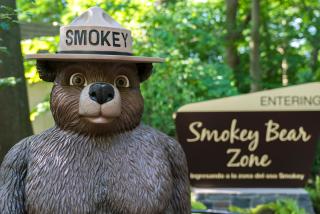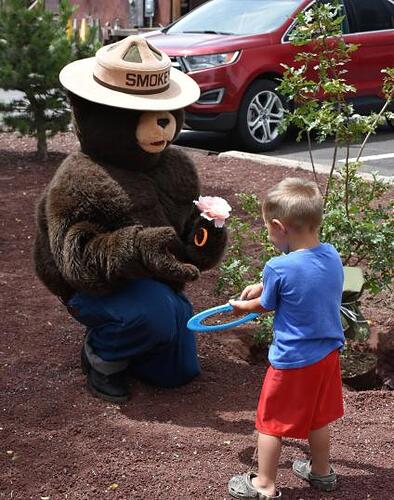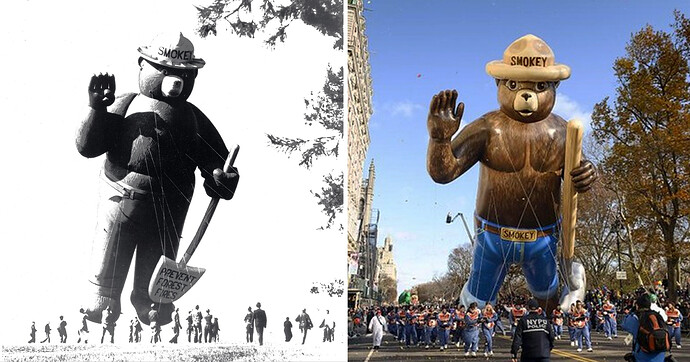Only You
Keeping Smokey Bear’s message alive for generations
Robert Hudson Westover
USDA Forest Service
October 11, 2023
(USDA Forest Service photo)
It’s been a long drive and an even longer work week, but your spirit lightens at the thought of enjoying a weekend in the great outdoors. As thoughts of work fade away and the wild landscape fills your windshield you notice a slightly faded roadside sign with the familiar bear from your childhood. Smokey Bear is always reminding those driving past, “Only you can prevent wildfires.” That’s his message, and it often means you’re in a national forest or any number of public lands ready to enjoy all that nature has to offer.
As you turn another bend you see a sign about the fire danger level today, and you think back to a news report about the USDA Forest Service purposely using fire to help the forest and you begin to wonder, “Is Smokey’s message of fire prevention outdated like a rotary telephone or a compact disc?”
Understandably, some might think Smokey’s message of wildfire prevention contradicts the Forest Service plan to use prescribed fire and some naturally ignited wildfires to restore forest health. If it is so important to prevent wildfires, why are land managers purposely setting them?
While preventing accidental or irresponsible human-caused fires is critical for avoiding unwanted wildfires, many national forests and grasslands need prescribed fires, or in some cases natural fire, to become and/or remain healthy.
A young boy plays frisbee with Smokey Bear at his tree planting ceremony. Kaibab National Forest, Williams, AZ. (USDA Forest Service photo by Dyan Bone)
Many indigenous cultures have practiced intentional, cultural burning for thousands of years to improve forests and game production. It is no secret to them that fire is beneficial. Because without fire, many forest types fail to regenerate or produce forage necessary for wildlife. In addition, excessive buildup of fallen trees, branches and other organic materials like leaves and pine needles can serve as kindling and help spread unwanted wildfires.
However, for many decades the Forest Service’s national wildfire management policy was to extinguish all wildfires by 10 a.m. the following morning to keep the size as small as possible. This put-it-out policy was partially in reaction to several massive wildfires, including The Great Fire of 1910, that consumed millions of acres in the West during the early part of the 20th century. Completely removing fire from the land prevented fire from playing its natural role in removing flammable debris, which instead built up to dangerous levels over time. The 10 a.m. policy is a strategy of the past that unfortunately helped create the wildfire crisis of today.
Alongside this thinking, but in no way a part of the 10 a.m. policy, came the legend of Smokey Bear.
The story of the real living Smokey Bear who, as a badly burned cub was rescued after a massive forest fire burned through the Capitan Mountains in New Mexico and later lived out a very happy bear necessity life at the National Zoo in Washington, DC captured the hearts of the American public.
In fact, Smokey was so popular in the early 1950s that he became the living icon of the wildfire prevention advertising campaign that had started in the 1940s and the message of “Only you can prevent forest fires” (later changed to “Only you can prevent wildfires”) was born.
Smokey Bear has been a bigger-than-life icon of fire prevention for 79 years. These two pictures of the Smokey balloons featured in the Macy’s Thanksgiving Day Parade were taken many decades apart with the black and white photo from 1968 and the color picture from 2019. (USDA Forest Service photos)
Fast forward to the 21st century and land managers now support the concept of prescribed fires, or even managing naturally started fires as long as they will bring no harm to people, infrastructure or the forest itself. Areas where it is safe to purposely burn or allow lightning fires to play their natural role are cleared of excessive flammable debris like fallen trees and pine needles and leaves. The timing of the intentional burning is also closely monitored to make sure the weather conditions are right.
But doesn’t Smokey want us to put out wildfires? He says all the time “Only You.” Well, that’s kind of right. Smokey does want you to prevent wildfires, but he’s talking about the fires humans start accidentally or through irresponsible behavior.
Simply put, people start well over 85% of all destructive and deadly wildland fires! With numbers like that, there’s no way nature can do its thing, or the Forest Service can get to the forest areas that need to be thinned for a prescribed fire.
With Smokey turning 80 this next year, his message, even after all these years, isn’t antiquated, or a relic of the past—it is a timeless reminder that yes, indeed, the power to help protect our communities, forests and grasslands from human-caused wildfire resides with “Only You.”

(USDA Forest Service phot


